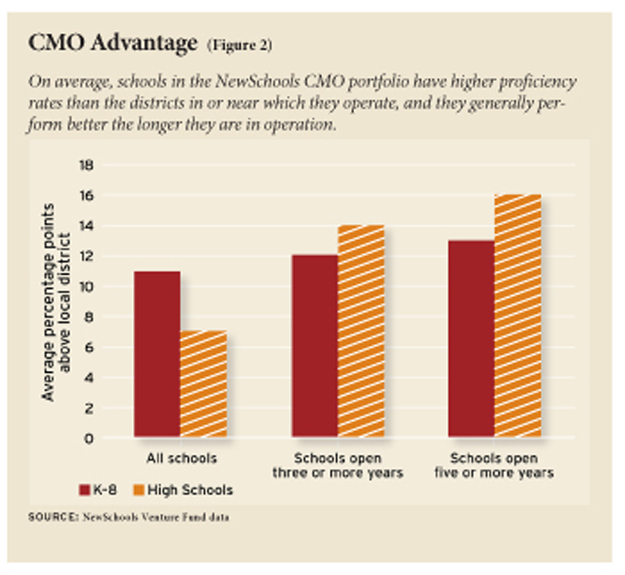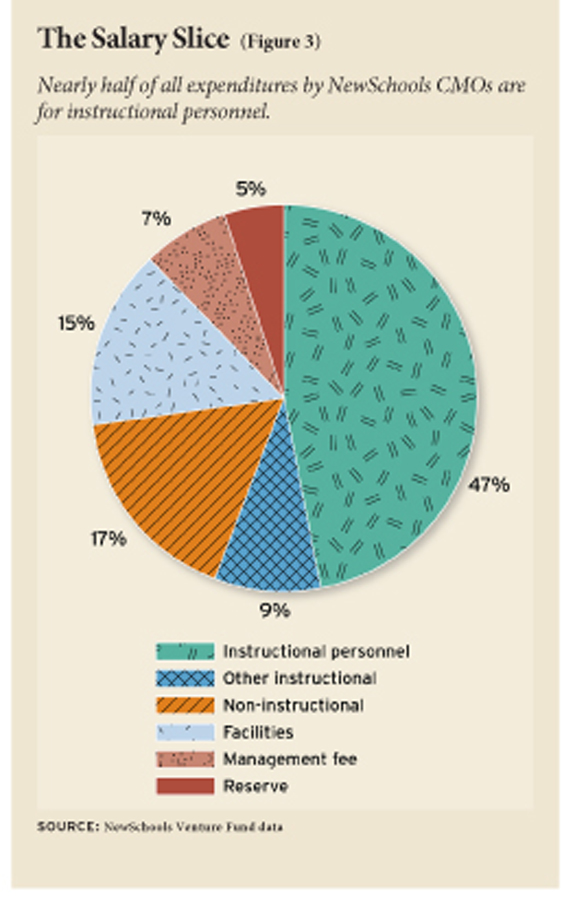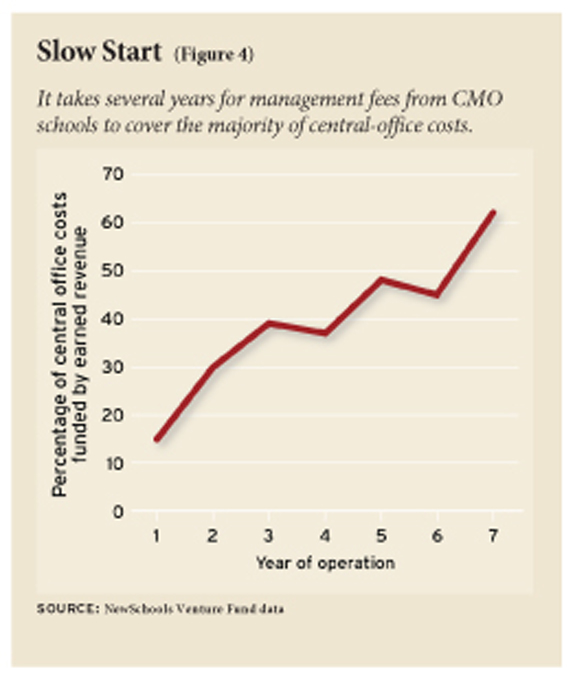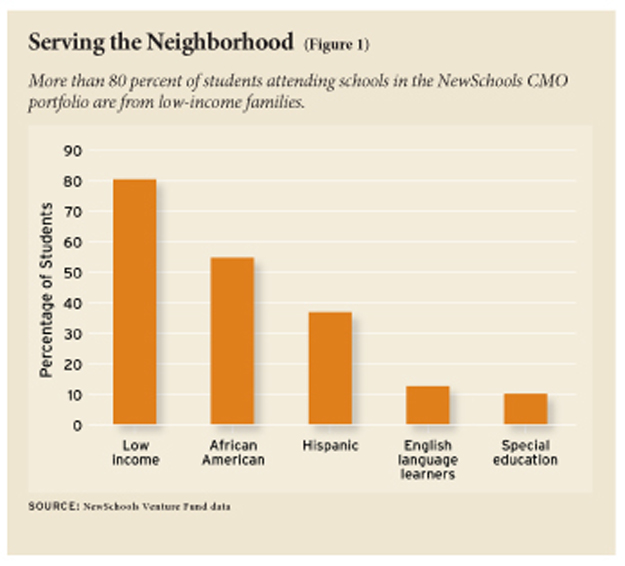 Charter schools are approaching the ripe old age of 20. Although more work remains if we are to fully understand this complex education reform “movement,” a growing body of data and research is being compiled about its strengths, weaknesses, and impact. An important subset of the charter school sector is just now receiving a similar level of scrutiny. Charter management organizations (CMOs) are integrated networks of charter schools that came on the scene around the turn of the century, a little less than 10 years after the first charter school opened its doors. According to a recent study by the Center on Reinventing Public Education, by 2008 CMOs accounted for more than 10 percent of the charter school market and had been the beneficiaries of at least $500 million in private philanthropy. At this scale, CMOs warrant a close look to improve our understanding of what they are, how they operate and perform, and whether they offer an adequate return on public and private investment.
Charter schools are approaching the ripe old age of 20. Although more work remains if we are to fully understand this complex education reform “movement,” a growing body of data and research is being compiled about its strengths, weaknesses, and impact. An important subset of the charter school sector is just now receiving a similar level of scrutiny. Charter management organizations (CMOs) are integrated networks of charter schools that came on the scene around the turn of the century, a little less than 10 years after the first charter school opened its doors. According to a recent study by the Center on Reinventing Public Education, by 2008 CMOs accounted for more than 10 percent of the charter school market and had been the beneficiaries of at least $500 million in private philanthropy. At this scale, CMOs warrant a close look to improve our understanding of what they are, how they operate and perform, and whether they offer an adequate return on public and private investment.
NewSchools Venture Fund, a nonprofit grant-making organization, has been for more than a decade one of the leading private funders of CMOs serving low-income urban neighborhoods. Along the way, we have amassed data and direct experience that provide a window into this world. Our analysis suggests that most of the CMOs in our “portfolio” are outperforming the local districts, especially for low-income students. Nevertheless, there is significant variation across our sample. The highest-performing CMOs in the NewSchools portfolio tend to be those that have embraced a “no excuses” approach to teaching and learning. These CMOs have created organizational and school cultures based on explicit expectations for both academic achievement and behavior, with meaningful consequences when those high expectations are not met.
Creating a New Market
In 1999, NewSchools Venture Fund made its first grant to University Public Schools, an emerging charter school network founded by Don Shalvey and Reed Hastings in California that would soon be renamed Aspire Public Schools. Supported by follow-on investments from NewSchools and the Bill & Melinda Gates Foundation, Aspire became the nation’s first nonprofit charter management organization. Since then, NewSchools has helped launch and grow many more CMOs, mostly in California, New York, Philadelphia, Chicago, and Washington, D.C. Working alongside NewSchools have been national funders like the Walton Family Foundation, the Fisher Fund, the Robertson Foundation, the Dell Foundation, the Broad Foundation, and the Charter School Growth Fund (see “The $500 Million Question,” forum, Winter 2011). These and a variety of locally based investors, notably the Robin Hood Foundation in New York and the Renaissance Schools Fund in Chicago, have channeled hundreds of millions of dollars into developing an entirely new sector of public education.
What’s a CMO?
Unlike EMOs (education management organizations), their somewhat older cousins, CMOs are not-for-profit. Their nonprofit status has at least three advantages: access to philanthropic capital, greater mission alignment, and diminished political resistance. And, unlike more loosely organized school networks, CMOs manage their schools directly, either under contract to a school board of trustees or under a fully integrated governance structure (in states where single charter school boards can operate multiple schools or campuses). Under such arrangements, a CMO has effective authority to hire and fire a school’s leadership team and to establish most of the educational and operational systems in each of its schools.
Most CMOs are organized much like a typical school district, at least on paper. There are centralized functions, including executive leadership and several operations teams, which provide certain administrative, financial, and educational support services to each school in the network. The schools are generally distinct units (often with separate legal status and their own boards of directors), but they operate under the overall control of the central office.
By the most recent national accounting in 2008, there were more than 80 CMOs, operating almost 500 schools. The most well-known charter school network in the country is the Knowledge Is Power Program (KIPP), but the KIPP Foundation is not a CMO. The 99 KIPP schools around the country are legally and operationally distinct from the foundation and, up until recently, each KIPP school stood on its own as an individual charter school. Over the past few years, several high-performing KIPP schools have begun to grow their own small clusters of schools, often managed in a way that qualifies them to be called CMOs.
My focus in this article is on the CMOs in the NewSchools portfolio, which often operate 10 to 20 schools or more, serve thousands of children, and are materially different from their smaller counterparts, especially in terms of finances and management. Beginning in the school year 2003–04, we began to collect data on our CMOs: their central offices, student performance, staffing, growth, and finances. The combination of quantitative data and a decade of firsthand observations of CMOs in action forms the basis for this analysis.
Although the data presented below represent a unique look inside some of the more well-established CMOs in the country, it is important to keep in mind their limitations. First, the NewSchools portfolio includes 18 CMOs, just a slice of the total market. Second, this sample was not randomly selected. Indeed, the NewSchools investment model is based on high standards and thorough diligence for each venture we support. Third, the achievement data that we have collected do not track individual student growth over time, but instead are based on annual snapshots of grade-level and school-level performance. Finally, the data are mostly self-reported by the CMOs, and although we have scrubbed the submissions, there may still be errors and inconsistencies.
It should also be noted that NewSchools is not an unbiased observer. We believe strongly in the potential of charter schools and CMOs to transform educational outcomes in historically underserved communities and on that basis have invested millions of dollars and thousands of hours. Nevertheless, we are committed to transparency and to letting the facts speak for themselves.
If the NewSchools CMO portfolio were a single school district, it would rank in size among the top 50 in the country, comparable to that of Fresno or Fort Worth. These CMOs operate exclusively in urban neighborhoods, serving predominantly low-income, high-need students (see Figure 1). The demographics of the CMO schools are roughly similar to nearby district-run schools.
On average, each CMO operates about a dozen schools, with future growth projected to reach just over 20 schools each. Our CMOs have been adding an average of 1.6 schools per year, although the pace of new school openings in any CMO is often uneven from year to year. The average annual CMO enrollment growth rate has been just over 45 percent. Many schools open with one or two grades and grow upward, adding one grade per year, to keep pace with the original cohort of students. Average school size at full enrollment is 442 students. Half of our 18 CMOs serve (or will serve) students in grades K through 12, three serve middle and high school, three are networks of elementary schools (including K–8 schools), and three operate only high schools.
Closing the Achievement Gap
The first question in any discussion about CMO schools is, how good are they? Measuring school or student performance is fraught with problems, especially if the goal is to make comparisons across classrooms, schools, districts, or states. We do not propose to solve these problems here. Specifically, our analytical approach is to use statewide assessments to compare student performance in our CMOs’ schools to that of students in the local district and state. Although we are able to track school and grade-level performance over time, our data set does not capture individual student results. Consequently, we are unable to measure directly the value our schools are adding to their students’ learning growth, relative to other schools. Given the similar demographics between schools in our portfolio and those in their local districts, however, we believe it is possible to make reasonable, albeit imperfect, comparisons between these two samples.
Looking at each of the CMOs in the NewSchools portfolio individually, we find that half are producing breakthrough results, with average proficiency rates that are at least 15 percentage points higher than their local districts. About 20 percent are outperforming the districts by a modest amount (proficiency rates that are between 5 and 15 percent higher than the districts). Another 20 percent are performing about the same as the local district, and the remaining CMOs are underperforming their districts. Performance among schools within a CMO can also vary. When comparing school-to-district gaps within a CMO, the typical standard deviation is almost 10 percentage points. This level of variation seems to hold for large and small CMOs alike.
 Viewed as a group, schools managed by our CMOs achieve rates of proficiency on state assessments in reading and math that average about 9 percentage points higher than those of schools in their local districts (see Figure 2). The gap widens to almost 12 percentage points when we compare only low-income students. Limiting the sample to schools open five years or more, the gap widens to more than 14 percentage points. Across the portfolio, CMO schools perform somewhat better in math than in reading, when benchmarked against their local peers on state assessments. On average, the math-reading proficiency gap is about 4 percentage points. Not surprisingly, the performance of these CMO schools relative to their non-low-income peers statewide is not as impressive.
Viewed as a group, schools managed by our CMOs achieve rates of proficiency on state assessments in reading and math that average about 9 percentage points higher than those of schools in their local districts (see Figure 2). The gap widens to almost 12 percentage points when we compare only low-income students. Limiting the sample to schools open five years or more, the gap widens to more than 14 percentage points. Across the portfolio, CMO schools perform somewhat better in math than in reading, when benchmarked against their local peers on state assessments. On average, the math-reading proficiency gap is about 4 percentage points. Not surprisingly, the performance of these CMO schools relative to their non-low-income peers statewide is not as impressive.
Although the NewSchools data set does not include state test results for individual students, it does include grade-level performance for most schools, which makes it possible to track improvement of cohorts of students from one year to the next. Looking at these data across all the elementary and middle schools that had test results for at least one grade in 2007, one finds a fairly consistent pattern of improvement. Annual math gains between 2007 and 2010 were almost 6 percentage points, while reading gains averaged more than 8 points per year.
Critics often suggest that superior performance in the charter sector is a result of high levels of attrition, caused by implicit or explicit efforts on the part of school staff to “counsel out” the students who are hardest to educate. Excluding students who move away, our data show average attrition rates of about 12 percent, compared to many schools in high-poverty urban neighborhoods that have annual attrition rates of close to one-third. Interestingly, the highest performers in our portfolio have below-average attrition rates of approximately 9 percent, while the lowest performers have above-average attrition rates of close to 20 percent. Apparently, the dynamic is what one would hope for: Parents at higher-performing schools are more likely to stay put, while those at lower-performing schools are voting with their feet.
A recent study commissioned by America’s Promise Alliance found that the average four-year graduation rate nationally is approximately 75 percent. Graduation rates among minority students are typically less than 65 percent, and among large urban school systems, graduation rates fall below 55 percent. Across the NewSchools CMO portfolio, comparable graduation rates average 65 percent. According to a 2010 U.S. Labor Department study, just over 70 percent of the graduating class of 2009 enrolled in college the following fall. Statistics for low-income students show the college-going rate for high school graduates at 57 percent. Eighty-four percent of graduating seniors from our CMOs enrolled in college, almost 60 percent in four-year colleges.
Finances and Staffing
The second question about CMOs is inevitably, how much do they cost? To answer this question, one has to examine financial data at both the school and central-office levels. Even though most CMO schools operate at breakeven on public revenue, many require significant private financial support before they can survive on public revenue alone. Philanthropy plays a key role in financing CMO start-up and growth.
The underlying economic model of all CMOs is based on predictable public revenue streams, tied to school enrollment. Average per-pupil public revenues (from all sources, including federal Charter School Program start-up grants) across the NewSchools portfolio were more than $11,500 in 2010, ranging from about $9,000 to $16,000, depending on the states and cities where schools are located. Public revenue for charter schools is typically 10 to 20 percent below per-pupil funding levels at neighboring district-run schools. In addition, charter schools are generally required to spend a significant portion of their budgets on rent or facilities-related debt service, an extra cost that is generally not included in most charter-school funding formulas. Taken together, these two factors can reduce charter school resources available for educational programs by 25 to 35 percent, relative to comparable district-run schools.
With a few exceptions, the vast majority of charter schools operated by NewSchools CMOs are self-sufficient on public revenues (excluding major capital costs). These schools typically incur deficits prior to their first year of operation (although these deficits are sometimes carried on the books of the CMO central office), as they begin to hire staff, upgrade facilities, and purchase equipment and supplies, all before the first students arrive and before any public tuition payments are made. About half of new schools run at breakeven during their first year of operation, although school-level deficits are common in the first three years of operation for those schools that begin with only one or two grade levels. About 40 percent of schools in the NewSchools portfolio incur cumulative deficits through their first three years of operation. These early deficits are often partially offset by start-up grants from the federal Charter School Program and the Walton Family Foundation, which together typically amount to more than $500,000 per school, spread out over several years.
 The largest component of a typical school operating budget within our CMO portfolio is instructional personnel, which comprises just under half of all school spending (see Figure 3). School administration and other noninstructional activities account for about 17 percent of expenditures on average, with facilities expenses close behind at 15 percent. Nonpersonnel instructional expenses are just under 10 percent of a typical budget, with the remainder going toward building reserves and CMO management fees.
The largest component of a typical school operating budget within our CMO portfolio is instructional personnel, which comprises just under half of all school spending (see Figure 3). School administration and other noninstructional activities account for about 17 percent of expenditures on average, with facilities expenses close behind at 15 percent. Nonpersonnel instructional expenses are just under 10 percent of a typical budget, with the remainder going toward building reserves and CMO management fees.
Operational spending per pupil during the 2010 school year was approximately $10,200, with average school surpluses of just under $500,000. Typically, these surpluses are used to build operating reserves of about 5 percent of a school’s yearly budget, to insure against normal cash-flow needs, temporary revenue interruptions, or fluctuations in annual per-pupil funding levels. Additional reserves are occasionally required as part of debt covenants, especially regarding bonds or loans for school buildings. Many schools have larger reserves to lay a financial foundation for a future purchase or renovation of a permanent facility.
The net philanthropic need for all schools managed by CMOs in the NewSchools portfolio is effectively zero, but since the schools that operate with surpluses generally do not cross-subsidize those with deficits (sometimes even within the same CMO), the actual school-level philanthropic need across the 71 schools in the portfolio with operating deficits was more than $25 million in the 2010 school year, or just under $360,000 per school.
The average central-office budget in 2010 was about $5.3 million, or more than $1,500 per pupil. More than 60 percent of central-office costs were for personnel. On average, central offices employed about 45 staff, which is 14 percent of total CMO staff, including school-level personnel. Staffing in the average CMO home office is dominated by personnel providing educational services (including assessment, curriculum, and professional development) and operations (including finance and facilities). Over the past five years, the relative sizes of these two categories have been moving in the opposite direction: The education staff has been growing (from 21 percent to 34 percent), while the operations staff has been shrinking (from 33 percent to 25 percent).The ratio of central-office staff to total CMO staff tends to decline over time, averaging about 30 percent in year one and falling to 12 percent by year seven. The average number of central-office staff per school fluctuates from year to year within most CMOs, but does not seem to consistently trend up or down over time. Across the NewSchools portfolio, central offices tend to have about 4.5 staff per school, although some of the larger CMOs are beginning to see this ratio drop.
As Figure 3 shows, CMO management fees are typically about 7 percent of a school’s budget, although it is not uncommon for fees to reach 10 percent or higher, depending on the breadth of services provided by the central office. On average, these fees covered more than 55 percent of central-office costs in the 2009-10 school year.
 During its first year of operation, a CMO central office earns relatively little of its revenue on management fees from preexisting schools. If the central office is established before the first school opens, annual fee revenue begins at zero. On average, fee revenue rises steadily as a percentage of total central-office costs, as the number of schools and students grows, exceeding 60 percent by year seven (see Figure 4).
During its first year of operation, a CMO central office earns relatively little of its revenue on management fees from preexisting schools. If the central office is established before the first school opens, annual fee revenue begins at zero. On average, fee revenue rises steadily as a percentage of total central-office costs, as the number of schools and students grows, exceeding 60 percent by year seven (see Figure 4).
Over the first seven years of operation, a typical CMO central office in the NewSchools portfolio incurred a cumulative operating deficit of more than $7.3 million, which translates into $800,000 to $900,000 per school, or up to $2,000 per seat at full enrollment. The distribution of deficits around this mean, however, is wide, ranging from under $300,000 per school to $2 million or more. Although it is difficult to allocate these costs precisely to specific activities, a significant portion of central-office expenditures is associated with growing the network of schools and building capacity for supporting new schools that are just beginning to come online.
Putting school-level and central-office economics together, CMOs in NewSchools’ portfolio have run cumulative deficits through the 2010 school year of more than $250 million, which amounts to about $3,150 per student at full enrollment for the schools that are currently up and running. Some school-level deficits are offset by surpluses at other schools within the same CMO network; other annual deficits at both the school and central-office levels are funded out of reserves built up through surpluses in prior years. As a result of these factors, the net philanthropic need to date has probably been closer to $200 million, which translates into an average per-seat need of about $2,600, or more than $1 million per school. In some cases, this figure has exceeded $4,000 per seat and in others it has been under $500 per seat. (These figures appear consistent with an unpublished analysis conducted by the Charter School Growth Fund on the CMOs it has supported.) To keep this in perspective, the 25 to 35 percent inequity in per-pupil funding for charter schools mentioned above amounted to approximately $275 million in lost revenue for our CMOs in the 2009-10 school year, an amount that swamps their annual philanthropic need, even if the public funding gap is greatly exaggerated.
Patterns and Connections
The final question about CMOs is, what makes the highest performers better than the rest? The data do not point consistently to the causes for this variation, but there are some differential patterns in spending, staffing, and school design that suggest possible sources. Based on direct observations by the New-Schools team over the years, the effectiveness of management and execution may be equally important, although it is not so easily quantified.
The five highest-performing CMOs in NewSchools’ portfolio operate 85 schools and serve more than 28,000 students. Their low-income students have proficiency rates that are more than 25 percentage points higher than those in their local districts. Comparing these CMOs with the bottom five performers in the NewSchools portfolio, we find similarities: school sizes are virtually the same; central-office spending as a share of total CMO spending is about the same, as is instructional spending as a percentage of total spending. Nevertheless, there are quantifiable differences: School-level spending per pupil is higher, central-office staff comprises a higher percentage of total CMO staff, and the share of central-office staff devoted to human resources is greater.
The 20 percent spending gap between the lowest and highest performers is clearly a significant factor, although at least one of the CMOs in the top five spends less per pupil than the portfolio average. Our high-performing organizations spend some of the extra money hiring more teachers. Although the average number of students per teacher among the top five performers is only slightly lower than among the bottom five (15.1 vs. 16.6), the average masks larger differences. Three of the top five performers have student-teacher ratios below 14, while three of the bottom five performers have ratios above 18.
Another important factor is the investment that the most successful CMOs are making in building the capacity of their central offices, especially the focus on recruiting and developing talent, as well as building instructional support systems that are grounded in the use of performance data. Based on our observations and feedback from school personnel, these deep levels of central-office investment appear to be adding significant value to student performance.
The rate and pattern of growth also appear to have some connection to performance differences. Although the high-performing CMOs have added new schools at a faster overall rate than the low performers (1.7 per year vs. 1.3), their average enrollment growth is slower (37 percent vs. 49 percent). At the same time, the pattern of growth among the high performers has been more consistent over time, while the low performers tended to grow faster early in their development.
Of at least equal importance are less easily quantifiable differences in school design. Specifically, the most successful organizations strive to create enthusiasm for learning and an expectation of college success for all, with a commitment to hard work and persistence in the face of initial failures or setbacks. They have adopted standards-based curricula, with an intensive focus on literacy and numeracy as the first foundation for academic achievement, which typically manifests itself in extra time for reading and math each day and a relatively heavy reliance on direct instruction and differentiated grouping, especially in the early grades. And they are increasingly focused on developing and deploying comprehensive student assessment and coaching systems to ensure more effective and consistent classroom practice, not just from year to year but during the course of each school year.
Although several factors appear to distinguish the highest from the lowest performers, there is no obvious or simple pattern. With respect to almost every variable that we have examined, there is a wide distribution of data from one CMO to another, even among organizations with comparable performance, operating in the same markets, serving similar grade levels. Although the data can give us some hints about where the answers lie, some of the differences in CMO performance are most likely tied to the quality of management and effectiveness of execution, factors that are difficult to measure. It has been said that high-performing schools are the result of a hundred 1-percent solutions. Not only is there no silver bullet, but there is not even a secret sauce. The key to success is an unflagging attention to detail and an uncompromising commitment to excellence in all things, from the classroom, to the hallway, to the principal’s office. As difficult as it is to do all of this while growing a new organization, it is even harder to sustain it over time, especially as the original founding teams give way to a new generation of leaders. Some CMOs are already beginning to take and pass this test, but it will remain one of their greatest enduring challenges.
James A. Peyser is managing partner for city funds at NewSchools Venture Fund and a former chairman of the Massachusetts Board of Education.
This article appeared in the Fall 2011 issue of Education Next. Suggested citation format:
Peyser, J.A. (2011). Unlocking the Secrets of High-Performing Charters: Tight management and “no excuses.” Education Next, 11(4), 36-43.



